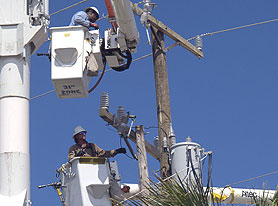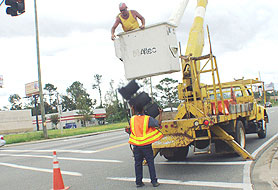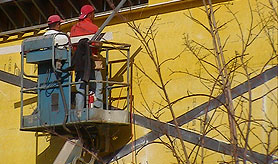Hurricane eMatrix
List of Activity Sheets » Operation-specific sheets
Use of Aerial Lifts

This picture shows actual disaster site work conditions and may not illustrate proper safety and health procedures.
Activity Description
- This activity sheet is for aerial lift operators and supervisors. It should be used in conjunction with the activity sheet for the particular activity in which an aerial lift will be used (building assessment, utility restoration). Additionally, operators of aerial lifts should refer to the other activity sheets that may apply (e.g., Work Zone Safety and Traffic Control within a Work Area); see related activity sheets below.
- As a result of high winds and flooding due to hurricanes, many structures will become unsound and will need to be assessed for damage. In addition, many communities will lose electrical service because the high winds caused electrical lines to fail. To help assess the damage and restore electrical service to affected communities, many aerial lifts will be used.
- While operators should first and foremost be familiar with the proper operation of this equipment, this activity sheet is provided to advise them of controls for hazards likely to be encountered.
- Response and recovery workers conducting this operation may be employed by Federal, State, local, and private employers. Review How to Use This Matrix in the introduction for a discussion of how this information may apply to different workers.
About the Activity Sheet
This activity sheet does not provide an in-depth analysis of OSHA standards and regulations and cannot address all hazards. It does not increase or diminish any OSHA requirement or employer obligation under those requirements. It is intended as a guide and quick reference for employers and response and recovery workers. The Matrix captures major activities involved in hurricane response and recovery, highlights many of the hazards associated with them, and recommends beneficial work practices, personal protective equipment (PPE), and other exposure control methods. Employers must evaluate the specific hazards associated with the job/operation at the site where the work is being performed.
Employers are responsible for providing a safe and healthful workplace for their workers. OSHA's role is to assure the safety and health of America's workers by setting and enforcing standards; providing training, outreach, and education; establishing partnerships; and encouraging continual improvement in workplace safety and health.
The Hazard Exposure and Risk Assessment Matrix for Hurricane Response and Recovery Work provides a general overview of particular topics related to current OSHA standards. It does not alter or determine compliance responsibilities in OSHA standards or the Occupational Safety and Health Act of 1970, or the equivalent State Plan standards and requirements. Because interpretations and enforcement policy may change over time, you should consult current OSHA/State Plan administrative interpretations and decisions by the Occupational Safety and Health Review Commission and the courts for additional guidance on OSHA compliance requirements. Employers should modify their procedures as appropriate when additional, relevant information becomes available.
General Recommendations
Key Engineering Controls and Work Practices. See general recommendations document.
Personal Protective Equipment. The general PPE is recommended for all response/recovery tasks/operations; only the additional PPE that may be needed for a specific hazard is noted below.
General PPE includes:
- Hard hat for overhead impact or electrical hazards
- Eye protection with side shields
- Gloves chosen for job hazards expected (e.g., heavy-duty leather work gloves for handling debris with sharp edges and/or chemical protective gloves appropriate for chemicals potentially contacted)
- ANSI-approved protective footwear
- Respiratory protection as necessary—N, R, or P95, filtering facepieces may be used for nuisance dusts (e.g., dried mud, dirt and silt) and mold (except mold remediation). Filters with a charcoal layer may be used for odors.
Recommendations Specific to Hazards Associated with Use of Aerial Lifts
Key Engineering Controls and Work Practices

- Do not exceed the boom and basket load limits specified by the manufacturer
- Ensure that brakes are set and outriggers are used and secured before boom is raised
- Never move the vehicle until the ladder is safely stored and secured (for ladder and tower trucks only) and all people are out of the basket (unless the equipment has been specifically designed for this purpose)
- Never override hydraulic, mechanical, or electrical safety devices
- Never allow an aerial lift to be used as a crane or material-lifting device
- Do not make any modifications to the aerial lift without a written certification from the manufacturer
Key Engineering Controls and Work Practices
- Ensure that users stand firmly on the floor and do not sit or climb on the edge or rails of the basket
- Ensure that no devices are used to elevate workers above the basket
Additional Personal Protective Equipment
- When working from an aerial lift, use a body harness that is properly attached (or body belt for tethering or restraint use only) for fall protection
Key Engineering Controls and Work Practices

- Assume that electrical lines are energized until proven otherwise. Lines and other conductors may become reenergized without warning as utilities are evaluated and restored after a disaster
- Inspect the work area for downed conductors and do not go near, drive over, or otherwise come in contact with them
- Downed electrical conductors can energize other objects, including fences, water pipes, bushes, trees, and telephone/CATV/fiber optic cables
- Unless deenergized and visibly grounded, maintain proper distance from overhead electrical power lines (at least 10 feet) and/or provide insulating barriers
- Do not approach any gas leaks; if a gas leak is detected, secure spark-producing devices (e.g., engines, tools, electronic, and communications equipment) and evacuate the area until the leak is secured
- Contact utility company to assist in locating, marking, and shutting off/purging utility lines that may pose a hazard or may be impacted; ensure that lines have been purged as needed before beginning work

Key Engineering Controls and Work Practices
- See Work Zone Safety and Traffic Control within a Work Area and Traffic Control within a Work Area activity sheet
Additional Personal Protective Equipment
- ANSI/ISEA 107-2004 compliant high visibility safety apparel and headwear
Key Engineering Controls and Work Practices
- See Heavy Equipment and Powered Industrial Truck Use activity sheet
- See Crane Use activity sheet
Additional Personal Protective Equipment
- Hearing protection when working around potential noise sources and when noise levels exceed 90dBA. A useful "rule of thumb"—if you cannot hold a conversation in a normal speaking voice with a person who is standing at arms length (approximately 3 feet), the noise level may exceed 90 dBA
Key Engineering Controls and Work Practices
- If hazardous chemical containers are found or leaking materials are detected:
- Do not use spark-producing devices (e.g., engines, tools, electronic, and communications equipment) in the immediate area
- Take self-protective measures (i.e., move to a safe distance upwind) and contact hazardous material response personnel for evaluation/removal before continuing work in the area
Additional Personal Protective Equipment
- Evaluate the need to revise protective clothing, respirator, and glove selection
Additional Medical Needs

This picture shows actual disaster site work conditions and may not illustrate proper safety and health procedures.
- Follow medical guidance and precautions outlined in the general recommendations document
Additional Training Needs
- Follow general site- and task-specific training guidelines as outlined in the general recommendations document
Related Activity Sheets
- Heavy Equipment and Powered Industrial Truck Use
- Work Zone Safety and Traffic Control within a Work Area
- Crane Use
Other Resources and References
- 29 CFR 1926 Subpart O, Motor vehicles, mechanized equipment, and marine operations. OSHA.
- 29 CFR 1926.453, Aerial lifts. OSHA Standard.
- Using Aerial Lifts. OSHA Fact Sheet, (2005).

